Case Study: Evaluating Language Development in a 31-Month-Old Child
VerifiedAdded on 2021/06/18
|16
|5277
|393
Case Study
AI Summary
This case study examines the language development of a 31-month-old child, analyzing their linguistic abilities, pragmatic function, and sentence structures. The study applies Locke's theory of neurolinguistic development to interpret the child's progress, identifying strengths and weaknesses in areas such as utterance acquisition and language elements. The analysis includes observations of the child's ability to form simple sentences, use vocabulary, and engage in social interactions, comparing these skills to expected developmental milestones. The discussion highlights the importance of caregiver support and the role of theoretical models in understanding language acquisition, referencing relevant research and providing insights into the child's overall language development trajectory.
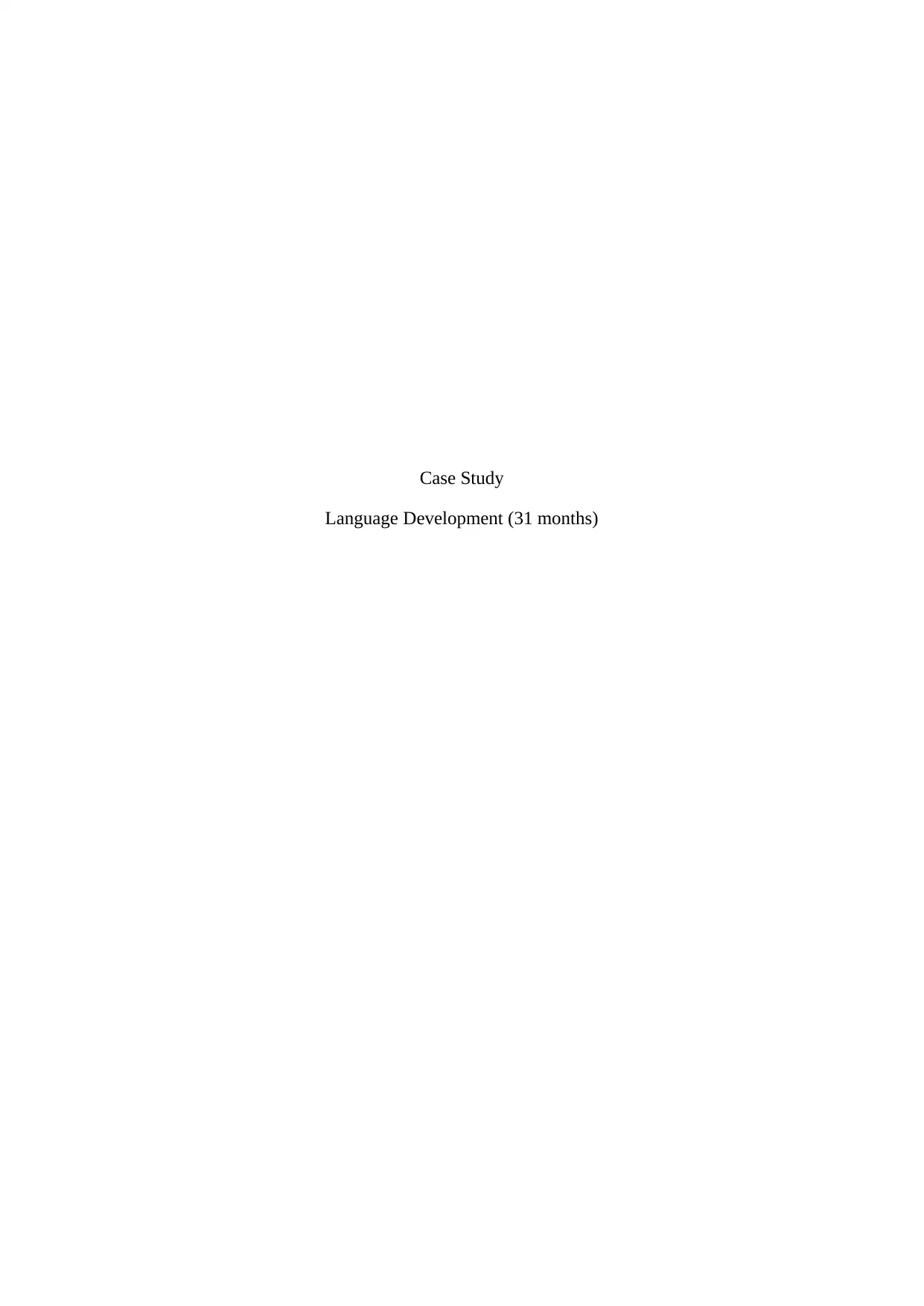
Case Study
Language Development (31 months)
Language Development (31 months)
Paraphrase This Document
Need a fresh take? Get an instant paraphrase of this document with our AI Paraphraser
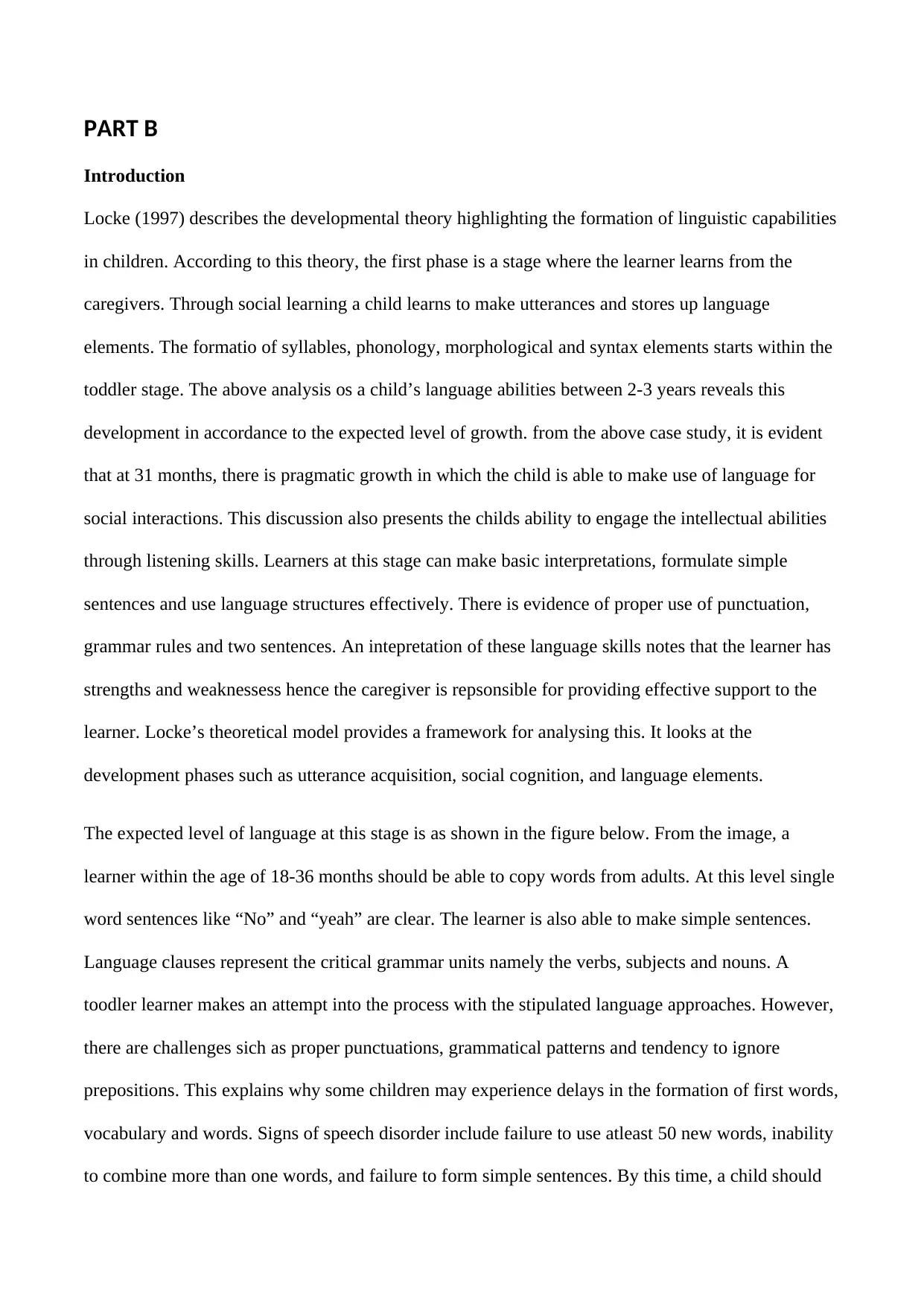
PART B
Introduction
Locke (1997) describes the developmental theory highlighting the formation of linguistic capabilities
in children. According to this theory, the first phase is a stage where the learner learns from the
caregivers. Through social learning a child learns to make utterances and stores up language
elements. The formatio of syllables, phonology, morphological and syntax elements starts within the
toddler stage. The above analysis os a child’s language abilities between 2-3 years reveals this
development in accordance to the expected level of growth. from the above case study, it is evident
that at 31 months, there is pragmatic growth in which the child is able to make use of language for
social interactions. This discussion also presents the childs ability to engage the intellectual abilities
through listening skills. Learners at this stage can make basic interpretations, formulate simple
sentences and use language structures effectively. There is evidence of proper use of punctuation,
grammar rules and two sentences. An intepretation of these language skills notes that the learner has
strengths and weaknessess hence the caregiver is repsonsible for providing effective support to the
learner. Locke’s theoretical model provides a framework for analysing this. It looks at the
development phases such as utterance acquisition, social cognition, and language elements.
The expected level of language at this stage is as shown in the figure below. From the image, a
learner within the age of 18-36 months should be able to copy words from adults. At this level single
word sentences like “No” and “yeah” are clear. The learner is also able to make simple sentences.
Language clauses represent the critical grammar units namely the verbs, subjects and nouns. A
toodler learner makes an attempt into the process with the stipulated language approaches. However,
there are challenges sich as proper punctuations, grammatical patterns and tendency to ignore
prepositions. This explains why some children may experience delays in the formation of first words,
vocabulary and words. Signs of speech disorder include failure to use atleast 50 new words, inability
to combine more than one words, and failure to form simple sentences. By this time, a child should
Introduction
Locke (1997) describes the developmental theory highlighting the formation of linguistic capabilities
in children. According to this theory, the first phase is a stage where the learner learns from the
caregivers. Through social learning a child learns to make utterances and stores up language
elements. The formatio of syllables, phonology, morphological and syntax elements starts within the
toddler stage. The above analysis os a child’s language abilities between 2-3 years reveals this
development in accordance to the expected level of growth. from the above case study, it is evident
that at 31 months, there is pragmatic growth in which the child is able to make use of language for
social interactions. This discussion also presents the childs ability to engage the intellectual abilities
through listening skills. Learners at this stage can make basic interpretations, formulate simple
sentences and use language structures effectively. There is evidence of proper use of punctuation,
grammar rules and two sentences. An intepretation of these language skills notes that the learner has
strengths and weaknessess hence the caregiver is repsonsible for providing effective support to the
learner. Locke’s theoretical model provides a framework for analysing this. It looks at the
development phases such as utterance acquisition, social cognition, and language elements.
The expected level of language at this stage is as shown in the figure below. From the image, a
learner within the age of 18-36 months should be able to copy words from adults. At this level single
word sentences like “No” and “yeah” are clear. The learner is also able to make simple sentences.
Language clauses represent the critical grammar units namely the verbs, subjects and nouns. A
toodler learner makes an attempt into the process with the stipulated language approaches. However,
there are challenges sich as proper punctuations, grammatical patterns and tendency to ignore
prepositions. This explains why some children may experience delays in the formation of first words,
vocabulary and words. Signs of speech disorder include failure to use atleast 50 new words, inability
to combine more than one words, and failure to form simple sentences. By this time, a child should
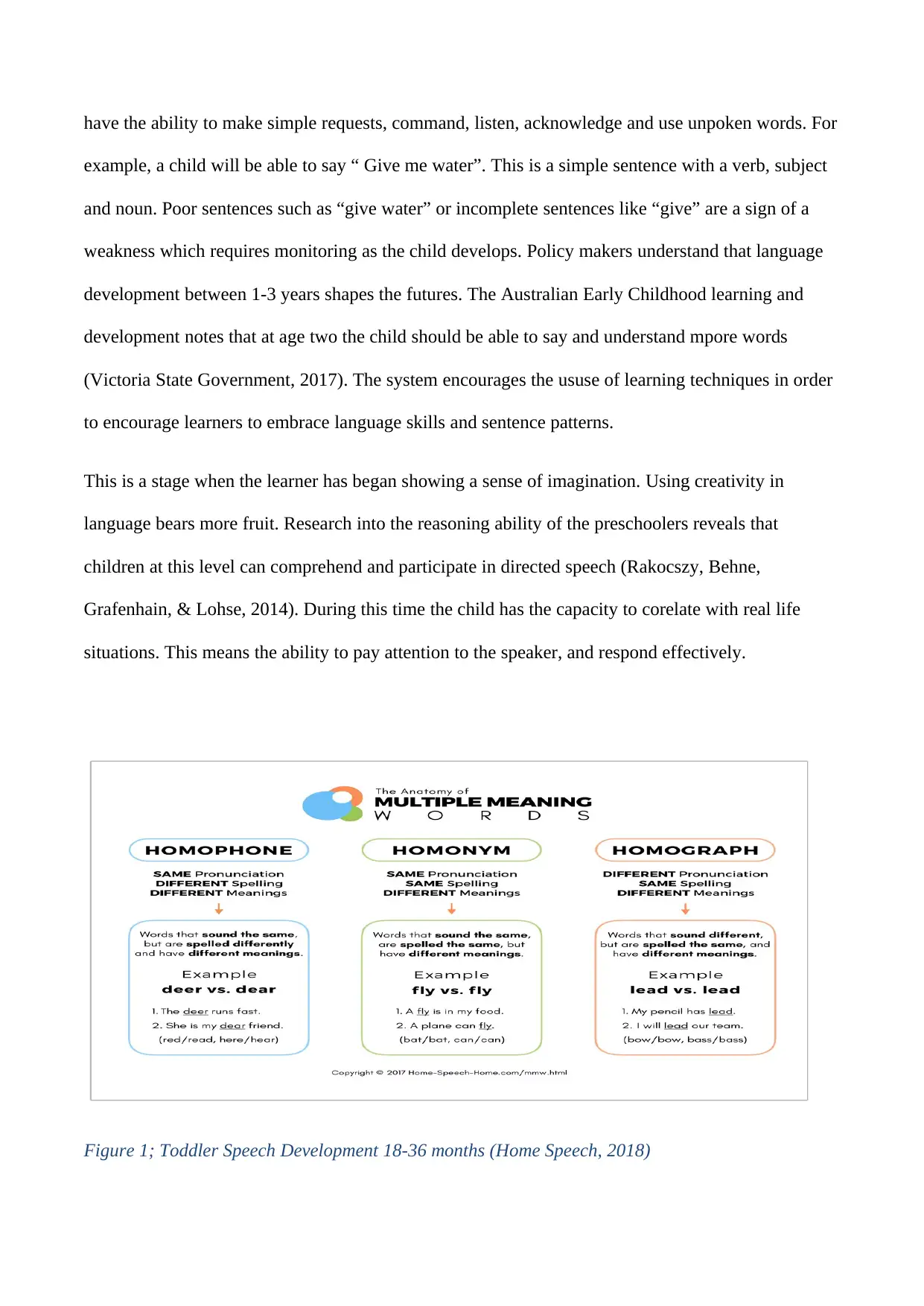
have the ability to make simple requests, command, listen, acknowledge and use unpoken words. For
example, a child will be able to say “ Give me water”. This is a simple sentence with a verb, subject
and noun. Poor sentences such as “give water” or incomplete sentences like “give” are a sign of a
weakness which requires monitoring as the child develops. Policy makers understand that language
development between 1-3 years shapes the futures. The Australian Early Childhood learning and
development notes that at age two the child should be able to say and understand mpore words
(Victoria State Government, 2017). The system encourages the ususe of learning techniques in order
to encourage learners to embrace language skills and sentence patterns.
This is a stage when the learner has began showing a sense of imagination. Using creativity in
language bears more fruit. Research into the reasoning ability of the preschoolers reveals that
children at this level can comprehend and participate in directed speech (Rakocszy, Behne,
Grafenhain, & Lohse, 2014). During this time the child has the capacity to corelate with real life
situations. This means the ability to pay attention to the speaker, and respond effectively.
Figure 1; Toddler Speech Development 18-36 months (Home Speech, 2018)
example, a child will be able to say “ Give me water”. This is a simple sentence with a verb, subject
and noun. Poor sentences such as “give water” or incomplete sentences like “give” are a sign of a
weakness which requires monitoring as the child develops. Policy makers understand that language
development between 1-3 years shapes the futures. The Australian Early Childhood learning and
development notes that at age two the child should be able to say and understand mpore words
(Victoria State Government, 2017). The system encourages the ususe of learning techniques in order
to encourage learners to embrace language skills and sentence patterns.
This is a stage when the learner has began showing a sense of imagination. Using creativity in
language bears more fruit. Research into the reasoning ability of the preschoolers reveals that
children at this level can comprehend and participate in directed speech (Rakocszy, Behne,
Grafenhain, & Lohse, 2014). During this time the child has the capacity to corelate with real life
situations. This means the ability to pay attention to the speaker, and respond effectively.
Figure 1; Toddler Speech Development 18-36 months (Home Speech, 2018)
⊘ This is a preview!⊘
Do you want full access?
Subscribe today to unlock all pages.

Trusted by 1+ million students worldwide
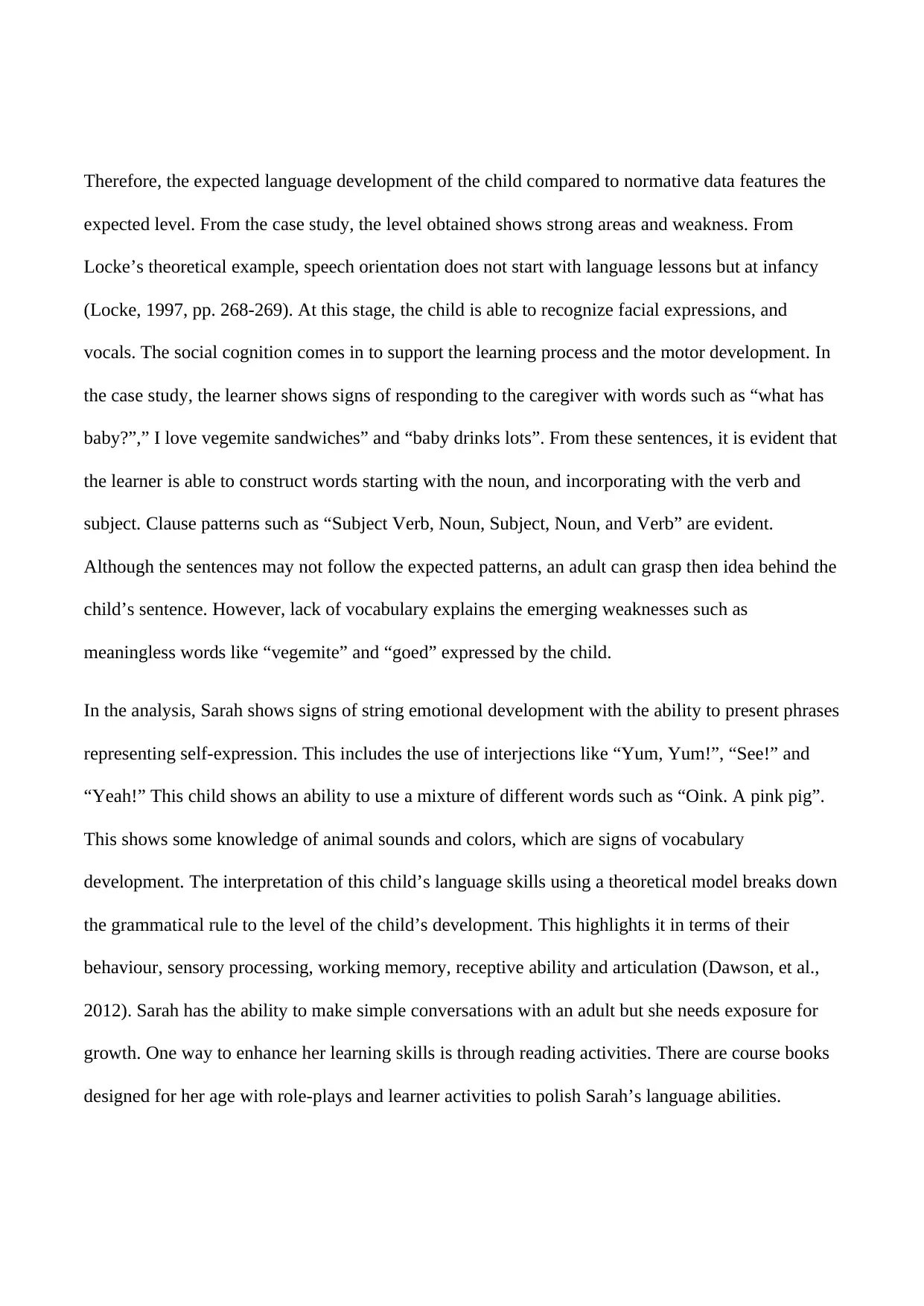
Therefore, the expected language development of the child compared to normative data features the
expected level. From the case study, the level obtained shows strong areas and weakness. From
Locke’s theoretical example, speech orientation does not start with language lessons but at infancy
(Locke, 1997, pp. 268-269). At this stage, the child is able to recognize facial expressions, and
vocals. The social cognition comes in to support the learning process and the motor development. In
the case study, the learner shows signs of responding to the caregiver with words such as “what has
baby?”,” I love vegemite sandwiches” and “baby drinks lots”. From these sentences, it is evident that
the learner is able to construct words starting with the noun, and incorporating with the verb and
subject. Clause patterns such as “Subject Verb, Noun, Subject, Noun, and Verb” are evident.
Although the sentences may not follow the expected patterns, an adult can grasp then idea behind the
child’s sentence. However, lack of vocabulary explains the emerging weaknesses such as
meaningless words like “vegemite” and “goed” expressed by the child.
In the analysis, Sarah shows signs of string emotional development with the ability to present phrases
representing self-expression. This includes the use of interjections like “Yum, Yum!”, “See!” and
“Yeah!” This child shows an ability to use a mixture of different words such as “Oink. A pink pig”.
This shows some knowledge of animal sounds and colors, which are signs of vocabulary
development. The interpretation of this child’s language skills using a theoretical model breaks down
the grammatical rule to the level of the child’s development. This highlights it in terms of their
behaviour, sensory processing, working memory, receptive ability and articulation (Dawson, et al.,
2012). Sarah has the ability to make simple conversations with an adult but she needs exposure for
growth. One way to enhance her learning skills is through reading activities. There are course books
designed for her age with role-plays and learner activities to polish Sarah’s language abilities.
expected level. From the case study, the level obtained shows strong areas and weakness. From
Locke’s theoretical example, speech orientation does not start with language lessons but at infancy
(Locke, 1997, pp. 268-269). At this stage, the child is able to recognize facial expressions, and
vocals. The social cognition comes in to support the learning process and the motor development. In
the case study, the learner shows signs of responding to the caregiver with words such as “what has
baby?”,” I love vegemite sandwiches” and “baby drinks lots”. From these sentences, it is evident that
the learner is able to construct words starting with the noun, and incorporating with the verb and
subject. Clause patterns such as “Subject Verb, Noun, Subject, Noun, and Verb” are evident.
Although the sentences may not follow the expected patterns, an adult can grasp then idea behind the
child’s sentence. However, lack of vocabulary explains the emerging weaknesses such as
meaningless words like “vegemite” and “goed” expressed by the child.
In the analysis, Sarah shows signs of string emotional development with the ability to present phrases
representing self-expression. This includes the use of interjections like “Yum, Yum!”, “See!” and
“Yeah!” This child shows an ability to use a mixture of different words such as “Oink. A pink pig”.
This shows some knowledge of animal sounds and colors, which are signs of vocabulary
development. The interpretation of this child’s language skills using a theoretical model breaks down
the grammatical rule to the level of the child’s development. This highlights it in terms of their
behaviour, sensory processing, working memory, receptive ability and articulation (Dawson, et al.,
2012). Sarah has the ability to make simple conversations with an adult but she needs exposure for
growth. One way to enhance her learning skills is through reading activities. There are course books
designed for her age with role-plays and learner activities to polish Sarah’s language abilities.
Paraphrase This Document
Need a fresh take? Get an instant paraphrase of this document with our AI Paraphraser
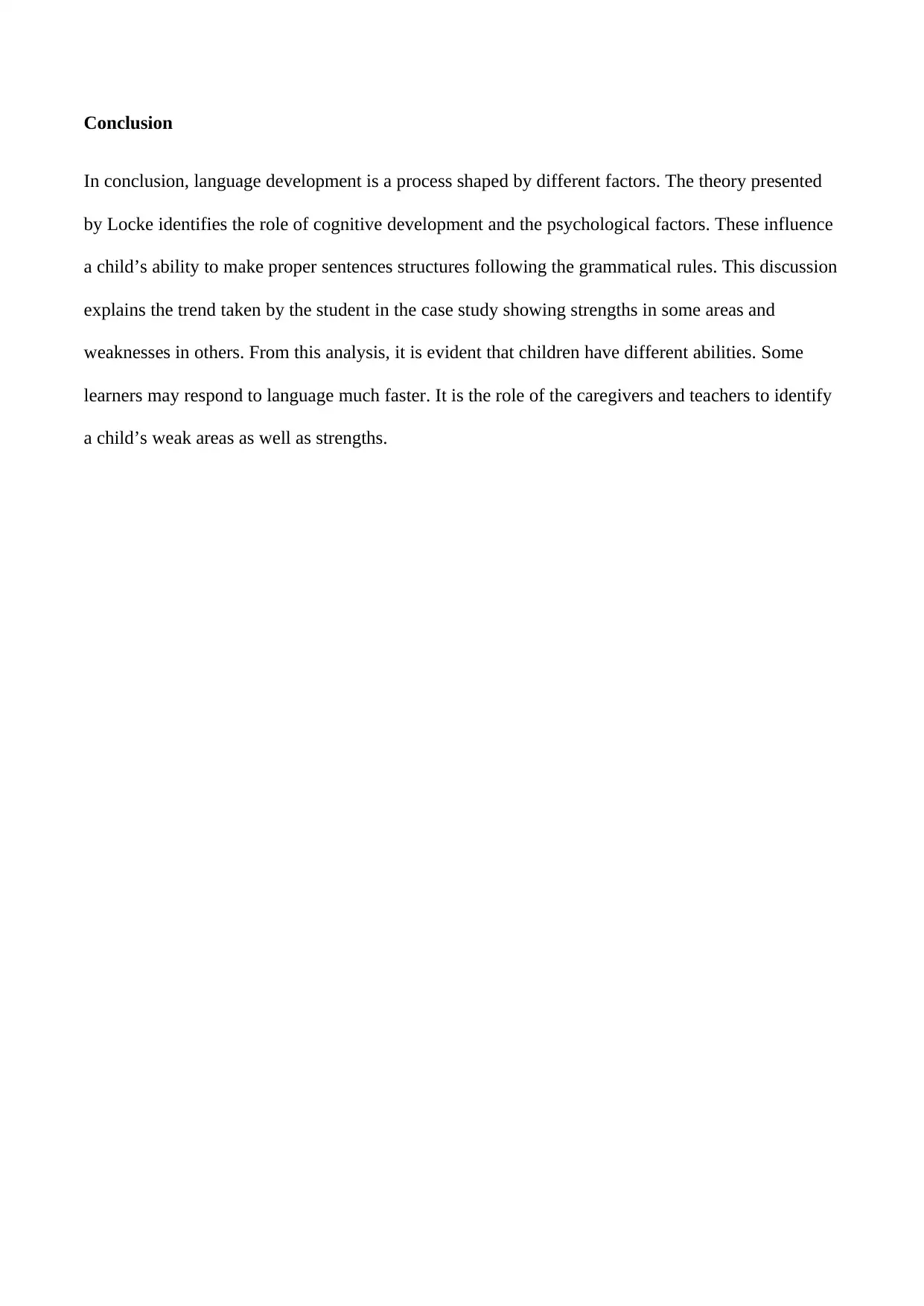
Conclusion
In conclusion, language development is a process shaped by different factors. The theory presented
by Locke identifies the role of cognitive development and the psychological factors. These influence
a child’s ability to make proper sentences structures following the grammatical rules. This discussion
explains the trend taken by the student in the case study showing strengths in some areas and
weaknesses in others. From this analysis, it is evident that children have different abilities. Some
learners may respond to language much faster. It is the role of the caregivers and teachers to identify
a child’s weak areas as well as strengths.
In conclusion, language development is a process shaped by different factors. The theory presented
by Locke identifies the role of cognitive development and the psychological factors. These influence
a child’s ability to make proper sentences structures following the grammatical rules. This discussion
explains the trend taken by the student in the case study showing strengths in some areas and
weaknesses in others. From this analysis, it is evident that children have different abilities. Some
learners may respond to language much faster. It is the role of the caregivers and teachers to identify
a child’s weak areas as well as strengths.
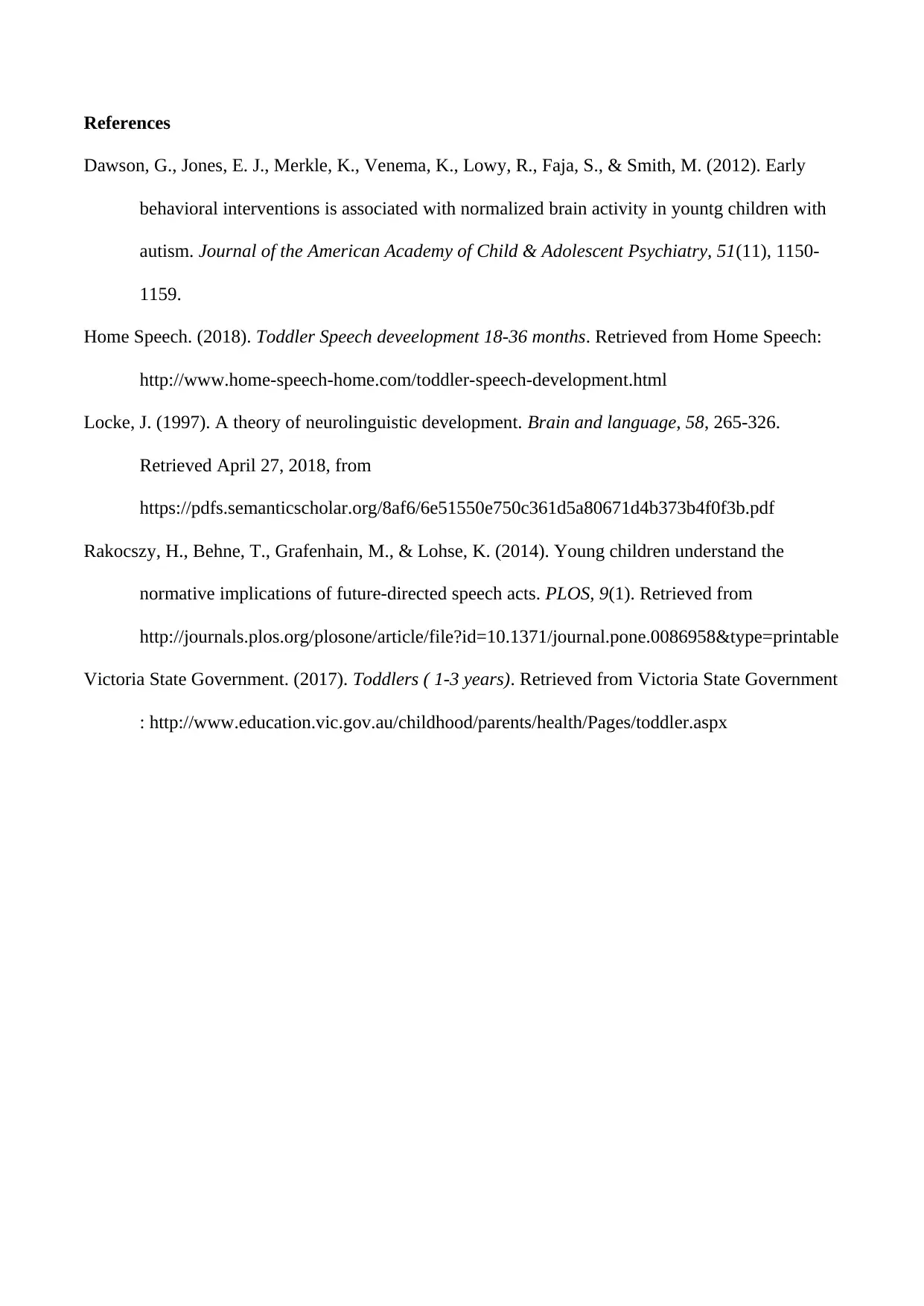
References
Dawson, G., Jones, E. J., Merkle, K., Venema, K., Lowy, R., Faja, S., & Smith, M. (2012). Early
behavioral interventions is associated with normalized brain activity in yountg children with
autism. Journal of the American Academy of Child & Adolescent Psychiatry, 51(11), 1150-
1159.
Home Speech. (2018). Toddler Speech deveelopment 18-36 months. Retrieved from Home Speech:
http://www.home-speech-home.com/toddler-speech-development.html
Locke, J. (1997). A theory of neurolinguistic development. Brain and language, 58, 265-326.
Retrieved April 27, 2018, from
https://pdfs.semanticscholar.org/8af6/6e51550e750c361d5a80671d4b373b4f0f3b.pdf
Rakocszy, H., Behne, T., Grafenhain, M., & Lohse, K. (2014). Young children understand the
normative implications of future-directed speech acts. PLOS, 9(1). Retrieved from
http://journals.plos.org/plosone/article/file?id=10.1371/journal.pone.0086958&type=printable
Victoria State Government. (2017). Toddlers ( 1-3 years). Retrieved from Victoria State Government
: http://www.education.vic.gov.au/childhood/parents/health/Pages/toddler.aspx
Dawson, G., Jones, E. J., Merkle, K., Venema, K., Lowy, R., Faja, S., & Smith, M. (2012). Early
behavioral interventions is associated with normalized brain activity in yountg children with
autism. Journal of the American Academy of Child & Adolescent Psychiatry, 51(11), 1150-
1159.
Home Speech. (2018). Toddler Speech deveelopment 18-36 months. Retrieved from Home Speech:
http://www.home-speech-home.com/toddler-speech-development.html
Locke, J. (1997). A theory of neurolinguistic development. Brain and language, 58, 265-326.
Retrieved April 27, 2018, from
https://pdfs.semanticscholar.org/8af6/6e51550e750c361d5a80671d4b373b4f0f3b.pdf
Rakocszy, H., Behne, T., Grafenhain, M., & Lohse, K. (2014). Young children understand the
normative implications of future-directed speech acts. PLOS, 9(1). Retrieved from
http://journals.plos.org/plosone/article/file?id=10.1371/journal.pone.0086958&type=printable
Victoria State Government. (2017). Toddlers ( 1-3 years). Retrieved from Victoria State Government
: http://www.education.vic.gov.au/childhood/parents/health/Pages/toddler.aspx
⊘ This is a preview!⊘
Do you want full access?
Subscribe today to unlock all pages.

Trusted by 1+ million students worldwide
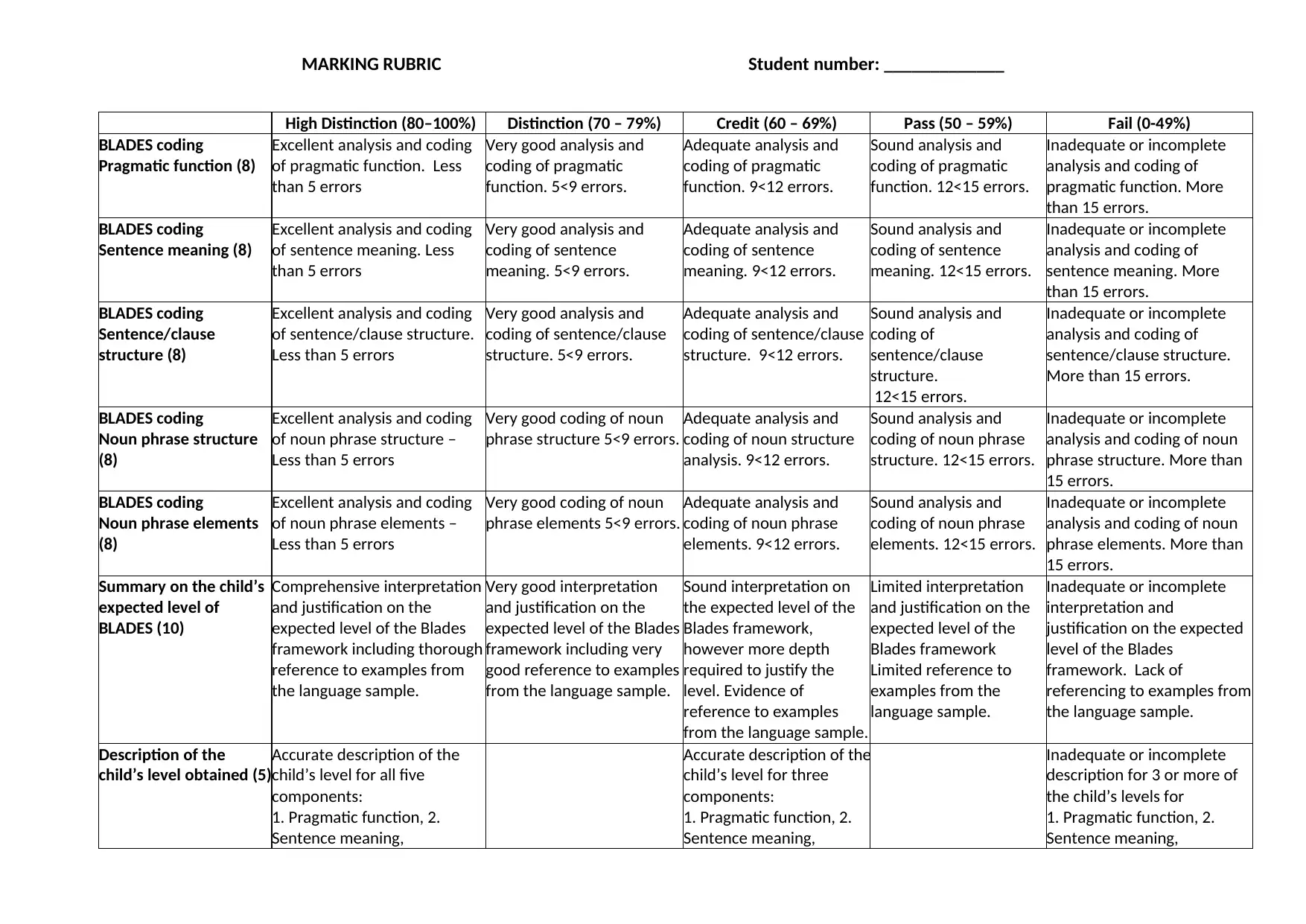
MARKING RUBRIC Student number: _____________
High Distinction (80–100%) Distinction (70 – 79%) Credit (60 – 69%) Pass (50 – 59%) Fail (0-49%)
BLADES coding
Pragmatic function (8)
Excellent analysis and coding
of pragmatic function. Less
than 5 errors
Very good analysis and
coding of pragmatic
function. 5<9 errors.
Adequate analysis and
coding of pragmatic
function. 9<12 errors.
Sound analysis and
coding of pragmatic
function. 12<15 errors.
Inadequate or incomplete
analysis and coding of
pragmatic function. More
than 15 errors.
BLADES coding
Sentence meaning (8)
Excellent analysis and coding
of sentence meaning. Less
than 5 errors
Very good analysis and
coding of sentence
meaning. 5<9 errors.
Adequate analysis and
coding of sentence
meaning. 9<12 errors.
Sound analysis and
coding of sentence
meaning. 12<15 errors.
Inadequate or incomplete
analysis and coding of
sentence meaning. More
than 15 errors.
BLADES coding
Sentence/clause
structure (8)
Excellent analysis and coding
of sentence/clause structure.
Less than 5 errors
Very good analysis and
coding of sentence/clause
structure. 5<9 errors.
Adequate analysis and
coding of sentence/clause
structure. 9<12 errors.
Sound analysis and
coding of
sentence/clause
structure.
12<15 errors.
Inadequate or incomplete
analysis and coding of
sentence/clause structure.
More than 15 errors.
BLADES coding
Noun phrase structure
(8)
Excellent analysis and coding
of noun phrase structure –
Less than 5 errors
Very good coding of noun
phrase structure 5<9 errors.
Adequate analysis and
coding of noun structure
analysis. 9<12 errors.
Sound analysis and
coding of noun phrase
structure. 12<15 errors.
Inadequate or incomplete
analysis and coding of noun
phrase structure. More than
15 errors.
BLADES coding
Noun phrase elements
(8)
Excellent analysis and coding
of noun phrase elements –
Less than 5 errors
Very good coding of noun
phrase elements 5<9 errors.
Adequate analysis and
coding of noun phrase
elements. 9<12 errors.
Sound analysis and
coding of noun phrase
elements. 12<15 errors.
Inadequate or incomplete
analysis and coding of noun
phrase elements. More than
15 errors.
Summary on the child’s
expected level of
BLADES (10)
Comprehensive interpretation
and justification on the
expected level of the Blades
framework including thorough
reference to examples from
the language sample.
Very good interpretation
and justification on the
expected level of the Blades
framework including very
good reference to examples
from the language sample.
Sound interpretation on
the expected level of the
Blades framework,
however more depth
required to justify the
level. Evidence of
reference to examples
from the language sample.
Limited interpretation
and justification on the
expected level of the
Blades framework
Limited reference to
examples from the
language sample.
Inadequate or incomplete
interpretation and
justification on the expected
level of the Blades
framework. Lack of
referencing to examples from
the language sample.
Description of the
child’s level obtained (5)
Accurate description of the
child’s level for all five
components:
1. Pragmatic function, 2.
Sentence meaning,
Accurate description of the
child’s level for three
components:
1. Pragmatic function, 2.
Sentence meaning,
Inadequate or incomplete
description for 3 or more of
the child’s levels for
1. Pragmatic function, 2.
Sentence meaning,
High Distinction (80–100%) Distinction (70 – 79%) Credit (60 – 69%) Pass (50 – 59%) Fail (0-49%)
BLADES coding
Pragmatic function (8)
Excellent analysis and coding
of pragmatic function. Less
than 5 errors
Very good analysis and
coding of pragmatic
function. 5<9 errors.
Adequate analysis and
coding of pragmatic
function. 9<12 errors.
Sound analysis and
coding of pragmatic
function. 12<15 errors.
Inadequate or incomplete
analysis and coding of
pragmatic function. More
than 15 errors.
BLADES coding
Sentence meaning (8)
Excellent analysis and coding
of sentence meaning. Less
than 5 errors
Very good analysis and
coding of sentence
meaning. 5<9 errors.
Adequate analysis and
coding of sentence
meaning. 9<12 errors.
Sound analysis and
coding of sentence
meaning. 12<15 errors.
Inadequate or incomplete
analysis and coding of
sentence meaning. More
than 15 errors.
BLADES coding
Sentence/clause
structure (8)
Excellent analysis and coding
of sentence/clause structure.
Less than 5 errors
Very good analysis and
coding of sentence/clause
structure. 5<9 errors.
Adequate analysis and
coding of sentence/clause
structure. 9<12 errors.
Sound analysis and
coding of
sentence/clause
structure.
12<15 errors.
Inadequate or incomplete
analysis and coding of
sentence/clause structure.
More than 15 errors.
BLADES coding
Noun phrase structure
(8)
Excellent analysis and coding
of noun phrase structure –
Less than 5 errors
Very good coding of noun
phrase structure 5<9 errors.
Adequate analysis and
coding of noun structure
analysis. 9<12 errors.
Sound analysis and
coding of noun phrase
structure. 12<15 errors.
Inadequate or incomplete
analysis and coding of noun
phrase structure. More than
15 errors.
BLADES coding
Noun phrase elements
(8)
Excellent analysis and coding
of noun phrase elements –
Less than 5 errors
Very good coding of noun
phrase elements 5<9 errors.
Adequate analysis and
coding of noun phrase
elements. 9<12 errors.
Sound analysis and
coding of noun phrase
elements. 12<15 errors.
Inadequate or incomplete
analysis and coding of noun
phrase elements. More than
15 errors.
Summary on the child’s
expected level of
BLADES (10)
Comprehensive interpretation
and justification on the
expected level of the Blades
framework including thorough
reference to examples from
the language sample.
Very good interpretation
and justification on the
expected level of the Blades
framework including very
good reference to examples
from the language sample.
Sound interpretation on
the expected level of the
Blades framework,
however more depth
required to justify the
level. Evidence of
reference to examples
from the language sample.
Limited interpretation
and justification on the
expected level of the
Blades framework
Limited reference to
examples from the
language sample.
Inadequate or incomplete
interpretation and
justification on the expected
level of the Blades
framework. Lack of
referencing to examples from
the language sample.
Description of the
child’s level obtained (5)
Accurate description of the
child’s level for all five
components:
1. Pragmatic function, 2.
Sentence meaning,
Accurate description of the
child’s level for three
components:
1. Pragmatic function, 2.
Sentence meaning,
Inadequate or incomplete
description for 3 or more of
the child’s levels for
1. Pragmatic function, 2.
Sentence meaning,
Paraphrase This Document
Need a fresh take? Get an instant paraphrase of this document with our AI Paraphraser
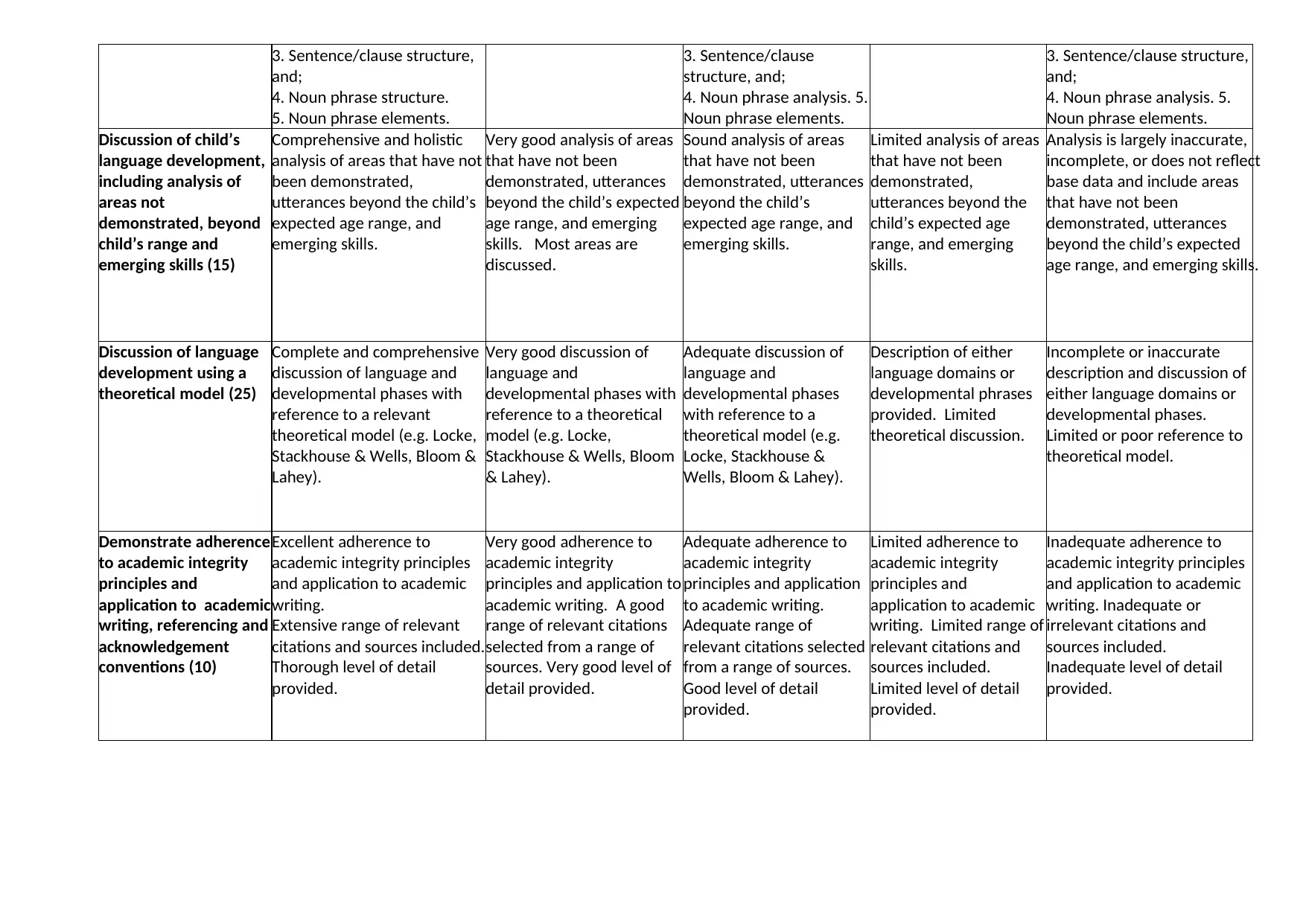
3. Sentence/clause structure,
and;
4. Noun phrase structure.
5. Noun phrase elements.
3. Sentence/clause
structure, and;
4. Noun phrase analysis. 5.
Noun phrase elements.
3. Sentence/clause structure,
and;
4. Noun phrase analysis. 5.
Noun phrase elements.
Discussion of child’s
language development,
including analysis of
areas not
demonstrated, beyond
child’s range and
emerging skills (15)
Comprehensive and holistic
analysis of areas that have not
been demonstrated,
utterances beyond the child’s
expected age range, and
emerging skills.
Very good analysis of areas
that have not been
demonstrated, utterances
beyond the child’s expected
age range, and emerging
skills. Most areas are
discussed.
Sound analysis of areas
that have not been
demonstrated, utterances
beyond the child’s
expected age range, and
emerging skills.
Limited analysis of areas
that have not been
demonstrated,
utterances beyond the
child’s expected age
range, and emerging
skills.
Analysis is largely inaccurate,
incomplete, or does not reflect
base data and include areas
that have not been
demonstrated, utterances
beyond the child’s expected
age range, and emerging skills.
Discussion of language
development using a
theoretical model (25)
Complete and comprehensive
discussion of language and
developmental phases with
reference to a relevant
theoretical model (e.g. Locke,
Stackhouse & Wells, Bloom &
Lahey).
Very good discussion of
language and
developmental phases with
reference to a theoretical
model (e.g. Locke,
Stackhouse & Wells, Bloom
& Lahey).
Adequate discussion of
language and
developmental phases
with reference to a
theoretical model (e.g.
Locke, Stackhouse &
Wells, Bloom & Lahey).
Description of either
language domains or
developmental phrases
provided. Limited
theoretical discussion.
Incomplete or inaccurate
description and discussion of
either language domains or
developmental phases.
Limited or poor reference to
theoretical model.
Demonstrate adherence
to academic integrity
principles and
application to academic
writing, referencing and
acknowledgement
conventions (10)
Excellent adherence to
academic integrity principles
and application to academic
writing.
Extensive range of relevant
citations and sources included.
Thorough level of detail
provided.
Very good adherence to
academic integrity
principles and application to
academic writing. A good
range of relevant citations
selected from a range of
sources. Very good level of
detail provided.
Adequate adherence to
academic integrity
principles and application
to academic writing.
Adequate range of
relevant citations selected
from a range of sources.
Good level of detail
provided.
Limited adherence to
academic integrity
principles and
application to academic
writing. Limited range of
relevant citations and
sources included.
Limited level of detail
provided.
Inadequate adherence to
academic integrity principles
and application to academic
writing. Inadequate or
irrelevant citations and
sources included.
Inadequate level of detail
provided.
and;
4. Noun phrase structure.
5. Noun phrase elements.
3. Sentence/clause
structure, and;
4. Noun phrase analysis. 5.
Noun phrase elements.
3. Sentence/clause structure,
and;
4. Noun phrase analysis. 5.
Noun phrase elements.
Discussion of child’s
language development,
including analysis of
areas not
demonstrated, beyond
child’s range and
emerging skills (15)
Comprehensive and holistic
analysis of areas that have not
been demonstrated,
utterances beyond the child’s
expected age range, and
emerging skills.
Very good analysis of areas
that have not been
demonstrated, utterances
beyond the child’s expected
age range, and emerging
skills. Most areas are
discussed.
Sound analysis of areas
that have not been
demonstrated, utterances
beyond the child’s
expected age range, and
emerging skills.
Limited analysis of areas
that have not been
demonstrated,
utterances beyond the
child’s expected age
range, and emerging
skills.
Analysis is largely inaccurate,
incomplete, or does not reflect
base data and include areas
that have not been
demonstrated, utterances
beyond the child’s expected
age range, and emerging skills.
Discussion of language
development using a
theoretical model (25)
Complete and comprehensive
discussion of language and
developmental phases with
reference to a relevant
theoretical model (e.g. Locke,
Stackhouse & Wells, Bloom &
Lahey).
Very good discussion of
language and
developmental phases with
reference to a theoretical
model (e.g. Locke,
Stackhouse & Wells, Bloom
& Lahey).
Adequate discussion of
language and
developmental phases
with reference to a
theoretical model (e.g.
Locke, Stackhouse &
Wells, Bloom & Lahey).
Description of either
language domains or
developmental phrases
provided. Limited
theoretical discussion.
Incomplete or inaccurate
description and discussion of
either language domains or
developmental phases.
Limited or poor reference to
theoretical model.
Demonstrate adherence
to academic integrity
principles and
application to academic
writing, referencing and
acknowledgement
conventions (10)
Excellent adherence to
academic integrity principles
and application to academic
writing.
Extensive range of relevant
citations and sources included.
Thorough level of detail
provided.
Very good adherence to
academic integrity
principles and application to
academic writing. A good
range of relevant citations
selected from a range of
sources. Very good level of
detail provided.
Adequate adherence to
academic integrity
principles and application
to academic writing.
Adequate range of
relevant citations selected
from a range of sources.
Good level of detail
provided.
Limited adherence to
academic integrity
principles and
application to academic
writing. Limited range of
relevant citations and
sources included.
Limited level of detail
provided.
Inadequate adherence to
academic integrity principles
and application to academic
writing. Inadequate or
irrelevant citations and
sources included.
Inadequate level of detail
provided.
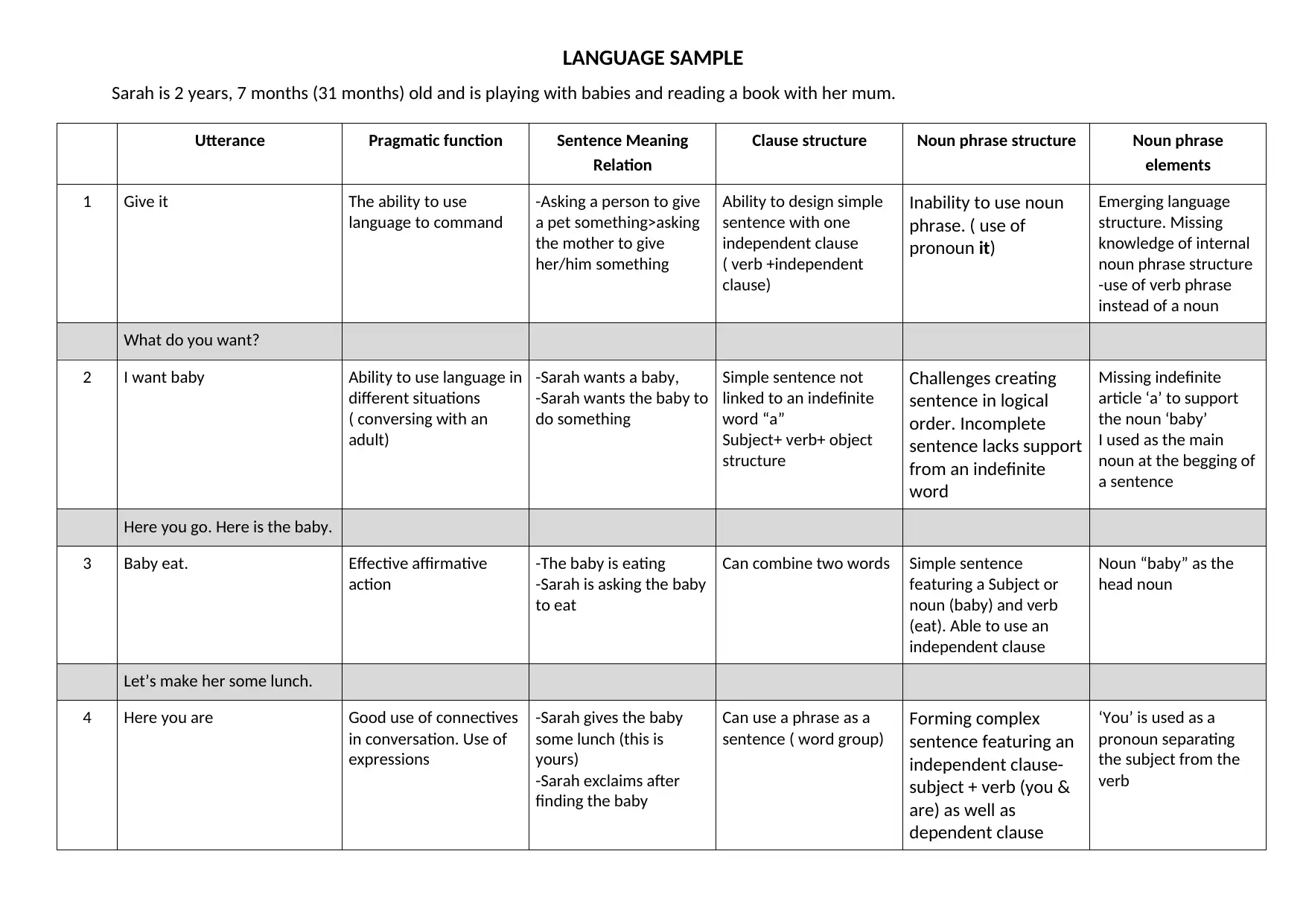
LANGUAGE SAMPLE
Sarah is 2 years, 7 months (31 months) old and is playing with babies and reading a book with her mum.
Utterance Pragmatic function Sentence Meaning
Relation
Clause structure Noun phrase structure Noun phrase
elements
1 Give it The ability to use
language to command
-Asking a person to give
a pet something>asking
the mother to give
her/him something
Ability to design simple
sentence with one
independent clause
( verb +independent
clause)
Inability to use noun
phrase. ( use of
pronoun it)
Emerging language
structure. Missing
knowledge of internal
noun phrase structure
-use of verb phrase
instead of a noun
What do you want?
2 I want baby Ability to use language in
different situations
( conversing with an
adult)
-Sarah wants a baby,
-Sarah wants the baby to
do something
Simple sentence not
linked to an indefinite
word “a”
Subject+ verb+ object
structure
Challenges creating
sentence in logical
order. Incomplete
sentence lacks support
from an indefinite
word
Missing indefinite
article ‘a’ to support
the noun ‘baby’
I used as the main
noun at the begging of
a sentence
Here you go. Here is the baby.
3 Baby eat. Effective affirmative
action
-The baby is eating
-Sarah is asking the baby
to eat
Can combine two words Simple sentence
featuring a Subject or
noun (baby) and verb
(eat). Able to use an
independent clause
Noun “baby” as the
head noun
Let’s make her some lunch.
4 Here you are Good use of connectives
in conversation. Use of
expressions
-Sarah gives the baby
some lunch (this is
yours)
-Sarah exclaims after
finding the baby
Can use a phrase as a
sentence ( word group)
Forming complex
sentence featuring an
independent clause-
subject + verb (you &
are) as well as
dependent clause
‘You’ is used as a
pronoun separating
the subject from the
verb
Sarah is 2 years, 7 months (31 months) old and is playing with babies and reading a book with her mum.
Utterance Pragmatic function Sentence Meaning
Relation
Clause structure Noun phrase structure Noun phrase
elements
1 Give it The ability to use
language to command
-Asking a person to give
a pet something>asking
the mother to give
her/him something
Ability to design simple
sentence with one
independent clause
( verb +independent
clause)
Inability to use noun
phrase. ( use of
pronoun it)
Emerging language
structure. Missing
knowledge of internal
noun phrase structure
-use of verb phrase
instead of a noun
What do you want?
2 I want baby Ability to use language in
different situations
( conversing with an
adult)
-Sarah wants a baby,
-Sarah wants the baby to
do something
Simple sentence not
linked to an indefinite
word “a”
Subject+ verb+ object
structure
Challenges creating
sentence in logical
order. Incomplete
sentence lacks support
from an indefinite
word
Missing indefinite
article ‘a’ to support
the noun ‘baby’
I used as the main
noun at the begging of
a sentence
Here you go. Here is the baby.
3 Baby eat. Effective affirmative
action
-The baby is eating
-Sarah is asking the baby
to eat
Can combine two words Simple sentence
featuring a Subject or
noun (baby) and verb
(eat). Able to use an
independent clause
Noun “baby” as the
head noun
Let’s make her some lunch.
4 Here you are Good use of connectives
in conversation. Use of
expressions
-Sarah gives the baby
some lunch (this is
yours)
-Sarah exclaims after
finding the baby
Can use a phrase as a
sentence ( word group)
Forming complex
sentence featuring an
independent clause-
subject + verb (you &
are) as well as
dependent clause
‘You’ is used as a
pronoun separating
the subject from the
verb
⊘ This is a preview!⊘
Do you want full access?
Subscribe today to unlock all pages.

Trusted by 1+ million students worldwide
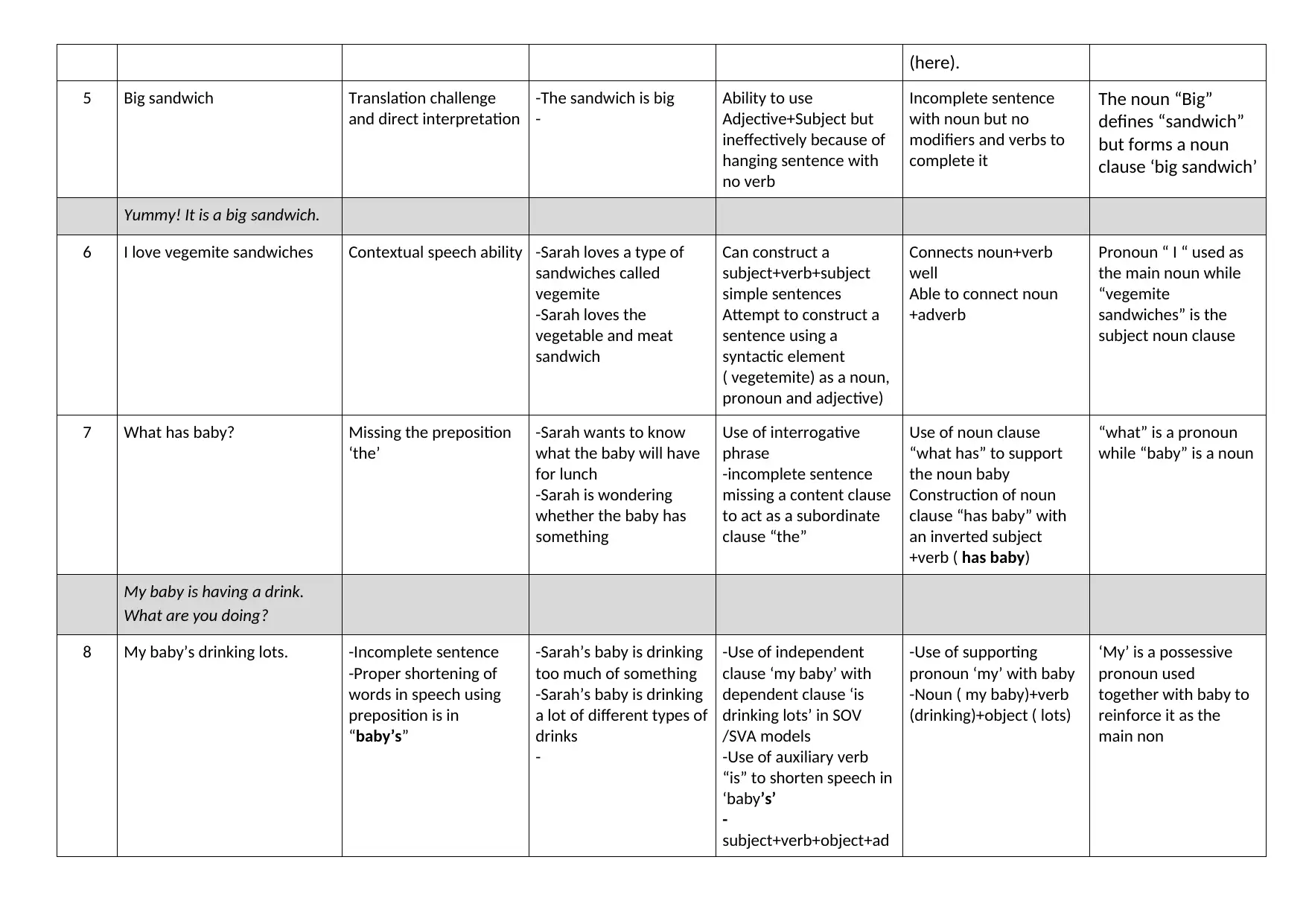
(here).
5 Big sandwich Translation challenge
and direct interpretation
-The sandwich is big
-
Ability to use
Adjective+Subject but
ineffectively because of
hanging sentence with
no verb
Incomplete sentence
with noun but no
modifiers and verbs to
complete it
The noun “Big”
defines “sandwich”
but forms a noun
clause ‘big sandwich’
Yummy! It is a big sandwich.
6 I love vegemite sandwiches Contextual speech ability -Sarah loves a type of
sandwiches called
vegemite
-Sarah loves the
vegetable and meat
sandwich
Can construct a
subject+verb+subject
simple sentences
Attempt to construct a
sentence using a
syntactic element
( vegetemite) as a noun,
pronoun and adjective)
Connects noun+verb
well
Able to connect noun
+adverb
Pronoun “ I “ used as
the main noun while
“vegemite
sandwiches” is the
subject noun clause
7 What has baby? Missing the preposition
‘the’
-Sarah wants to know
what the baby will have
for lunch
-Sarah is wondering
whether the baby has
something
Use of interrogative
phrase
-incomplete sentence
missing a content clause
to act as a subordinate
clause “the”
Use of noun clause
“what has” to support
the noun baby
Construction of noun
clause “has baby” with
an inverted subject
+verb ( has baby)
“what” is a pronoun
while “baby” is a noun
My baby is having a drink.
What are you doing?
8 My baby’s drinking lots. -Incomplete sentence
-Proper shortening of
words in speech using
preposition is in
“baby’s”
-Sarah’s baby is drinking
too much of something
-Sarah’s baby is drinking
a lot of different types of
drinks
-
-Use of independent
clause ‘my baby’ with
dependent clause ‘is
drinking lots’ in SOV
/SVA models
-Use of auxiliary verb
“is” to shorten speech in
‘baby’s’
-
subject+verb+object+ad
-Use of supporting
pronoun ‘my’ with baby
-Noun ( my baby)+verb
(drinking)+object ( lots)
‘My’ is a possessive
pronoun used
together with baby to
reinforce it as the
main non
5 Big sandwich Translation challenge
and direct interpretation
-The sandwich is big
-
Ability to use
Adjective+Subject but
ineffectively because of
hanging sentence with
no verb
Incomplete sentence
with noun but no
modifiers and verbs to
complete it
The noun “Big”
defines “sandwich”
but forms a noun
clause ‘big sandwich’
Yummy! It is a big sandwich.
6 I love vegemite sandwiches Contextual speech ability -Sarah loves a type of
sandwiches called
vegemite
-Sarah loves the
vegetable and meat
sandwich
Can construct a
subject+verb+subject
simple sentences
Attempt to construct a
sentence using a
syntactic element
( vegetemite) as a noun,
pronoun and adjective)
Connects noun+verb
well
Able to connect noun
+adverb
Pronoun “ I “ used as
the main noun while
“vegemite
sandwiches” is the
subject noun clause
7 What has baby? Missing the preposition
‘the’
-Sarah wants to know
what the baby will have
for lunch
-Sarah is wondering
whether the baby has
something
Use of interrogative
phrase
-incomplete sentence
missing a content clause
to act as a subordinate
clause “the”
Use of noun clause
“what has” to support
the noun baby
Construction of noun
clause “has baby” with
an inverted subject
+verb ( has baby)
“what” is a pronoun
while “baby” is a noun
My baby is having a drink.
What are you doing?
8 My baby’s drinking lots. -Incomplete sentence
-Proper shortening of
words in speech using
preposition is in
“baby’s”
-Sarah’s baby is drinking
too much of something
-Sarah’s baby is drinking
a lot of different types of
drinks
-
-Use of independent
clause ‘my baby’ with
dependent clause ‘is
drinking lots’ in SOV
/SVA models
-Use of auxiliary verb
“is” to shorten speech in
‘baby’s’
-
subject+verb+object+ad
-Use of supporting
pronoun ‘my’ with baby
-Noun ( my baby)+verb
(drinking)+object ( lots)
‘My’ is a possessive
pronoun used
together with baby to
reinforce it as the
main non
Paraphrase This Document
Need a fresh take? Get an instant paraphrase of this document with our AI Paraphraser
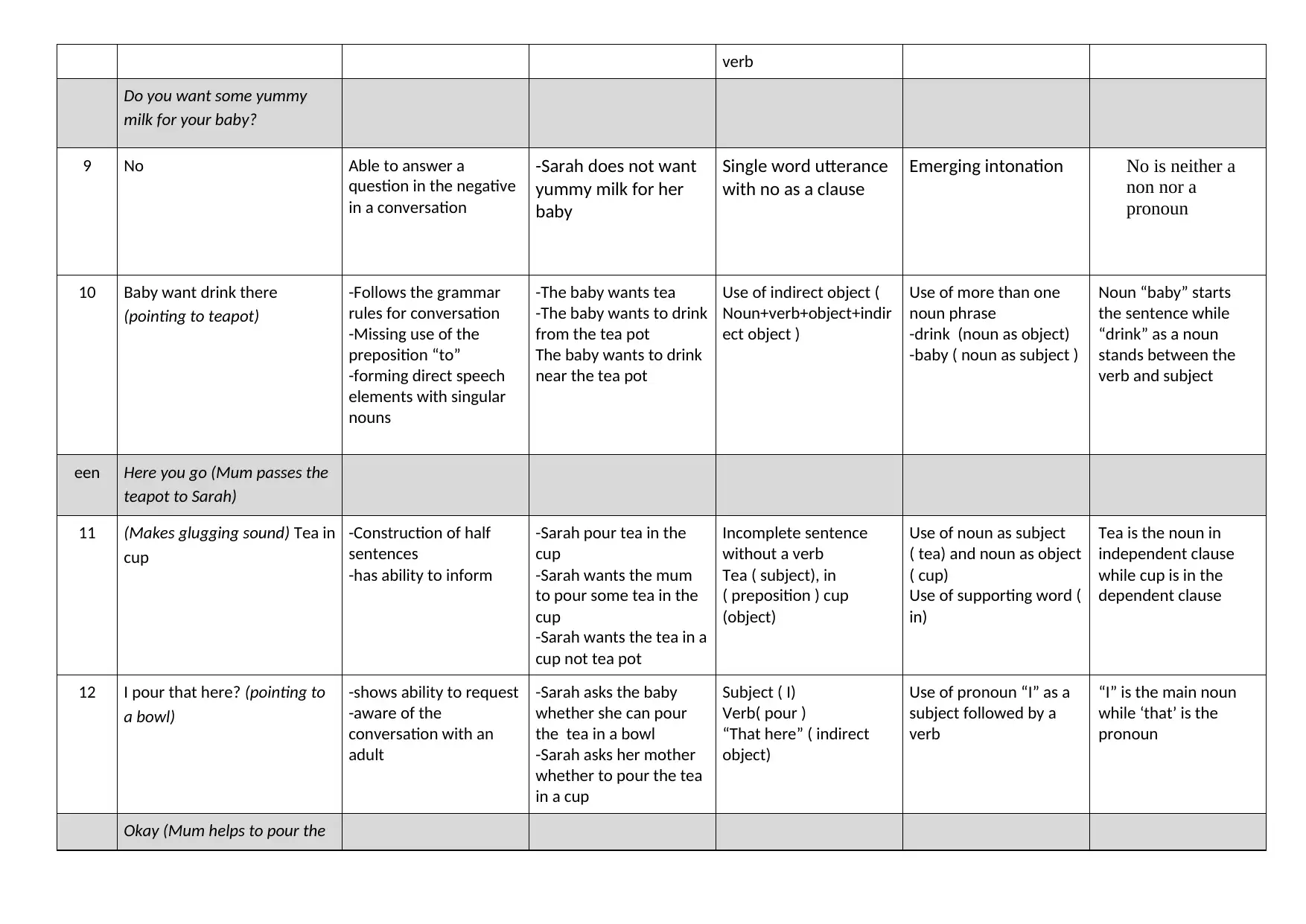
verb
Do you want some yummy
milk for your baby?
9 No Able to answer a
question in the negative
in a conversation
-Sarah does not want
yummy milk for her
baby
Single word utterance
with no as a clause
Emerging intonation No is neither a
non nor a
pronoun
10 Baby want drink there
(pointing to teapot)
-Follows the grammar
rules for conversation
-Missing use of the
preposition “to”
-forming direct speech
elements with singular
nouns
-The baby wants tea
-The baby wants to drink
from the tea pot
The baby wants to drink
near the tea pot
Use of indirect object (
Noun+verb+object+indir
ect object )
Use of more than one
noun phrase
-drink (noun as object)
-baby ( noun as subject )
Noun “baby” starts
the sentence while
“drink” as a noun
stands between the
verb and subject
een Here you go (Mum passes the
teapot to Sarah)
11 (Makes glugging sound) Tea in
cup
-Construction of half
sentences
-has ability to inform
-Sarah pour tea in the
cup
-Sarah wants the mum
to pour some tea in the
cup
-Sarah wants the tea in a
cup not tea pot
Incomplete sentence
without a verb
Tea ( subject), in
( preposition ) cup
(object)
Use of noun as subject
( tea) and noun as object
( cup)
Use of supporting word (
in)
Tea is the noun in
independent clause
while cup is in the
dependent clause
12 I pour that here? (pointing to
a bowl)
-shows ability to request
-aware of the
conversation with an
adult
-Sarah asks the baby
whether she can pour
the tea in a bowl
-Sarah asks her mother
whether to pour the tea
in a cup
Subject ( I)
Verb( pour )
“That here” ( indirect
object)
Use of pronoun “I” as a
subject followed by a
verb
“I” is the main noun
while ‘that’ is the
pronoun
Okay (Mum helps to pour the
Do you want some yummy
milk for your baby?
9 No Able to answer a
question in the negative
in a conversation
-Sarah does not want
yummy milk for her
baby
Single word utterance
with no as a clause
Emerging intonation No is neither a
non nor a
pronoun
10 Baby want drink there
(pointing to teapot)
-Follows the grammar
rules for conversation
-Missing use of the
preposition “to”
-forming direct speech
elements with singular
nouns
-The baby wants tea
-The baby wants to drink
from the tea pot
The baby wants to drink
near the tea pot
Use of indirect object (
Noun+verb+object+indir
ect object )
Use of more than one
noun phrase
-drink (noun as object)
-baby ( noun as subject )
Noun “baby” starts
the sentence while
“drink” as a noun
stands between the
verb and subject
een Here you go (Mum passes the
teapot to Sarah)
11 (Makes glugging sound) Tea in
cup
-Construction of half
sentences
-has ability to inform
-Sarah pour tea in the
cup
-Sarah wants the mum
to pour some tea in the
cup
-Sarah wants the tea in a
cup not tea pot
Incomplete sentence
without a verb
Tea ( subject), in
( preposition ) cup
(object)
Use of noun as subject
( tea) and noun as object
( cup)
Use of supporting word (
in)
Tea is the noun in
independent clause
while cup is in the
dependent clause
12 I pour that here? (pointing to
a bowl)
-shows ability to request
-aware of the
conversation with an
adult
-Sarah asks the baby
whether she can pour
the tea in a bowl
-Sarah asks her mother
whether to pour the tea
in a cup
Subject ( I)
Verb( pour )
“That here” ( indirect
object)
Use of pronoun “I” as a
subject followed by a
verb
“I” is the main noun
while ‘that’ is the
pronoun
Okay (Mum helps to pour the
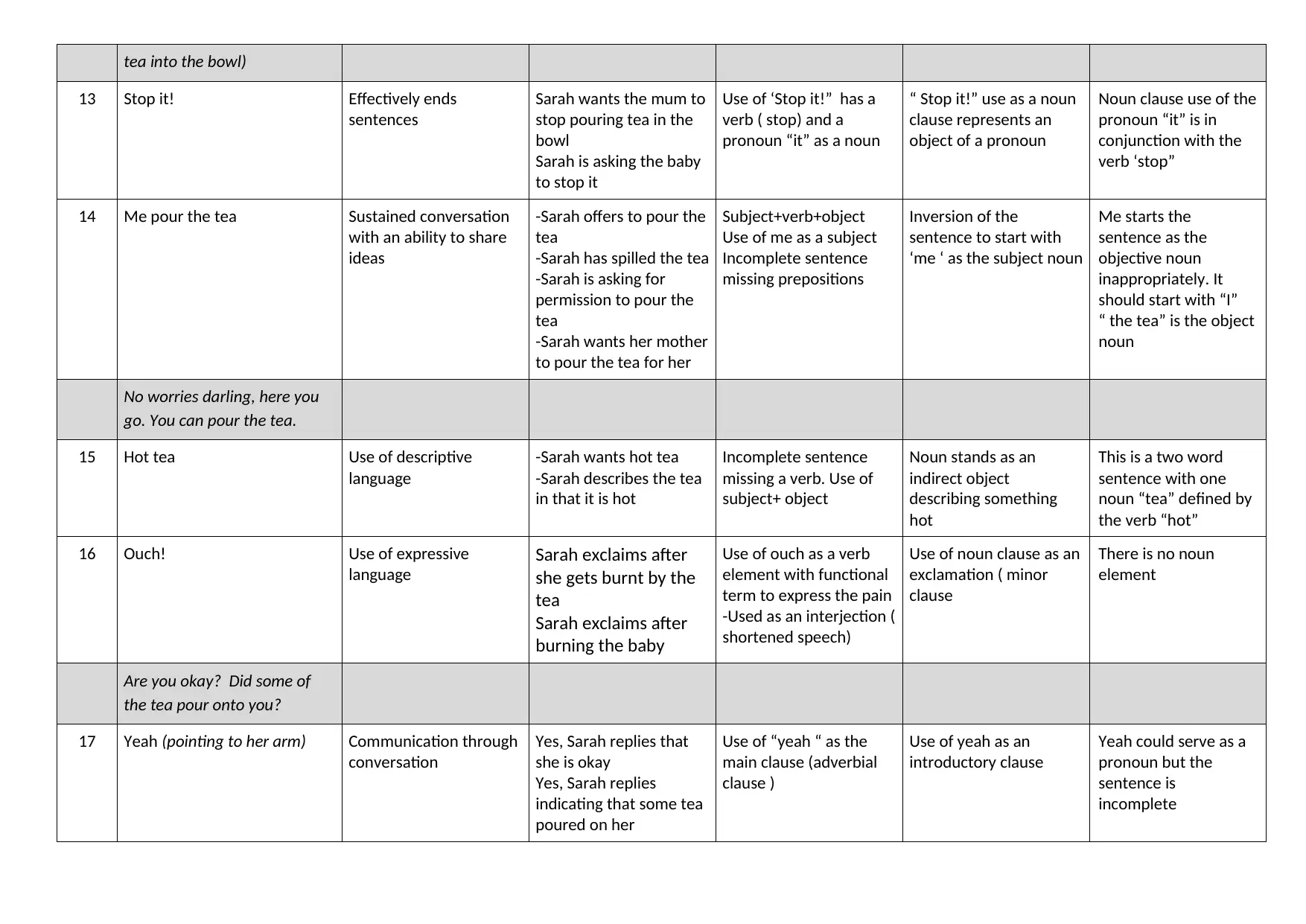
tea into the bowl)
13 Stop it! Effectively ends
sentences
Sarah wants the mum to
stop pouring tea in the
bowl
Sarah is asking the baby
to stop it
Use of ‘Stop it!” has a
verb ( stop) and a
pronoun “it” as a noun
“ Stop it!” use as a noun
clause represents an
object of a pronoun
Noun clause use of the
pronoun “it” is in
conjunction with the
verb ‘stop”
14 Me pour the tea Sustained conversation
with an ability to share
ideas
-Sarah offers to pour the
tea
-Sarah has spilled the tea
-Sarah is asking for
permission to pour the
tea
-Sarah wants her mother
to pour the tea for her
Subject+verb+object
Use of me as a subject
Incomplete sentence
missing prepositions
Inversion of the
sentence to start with
‘me ‘ as the subject noun
Me starts the
sentence as the
objective noun
inappropriately. It
should start with “I”
“ the tea” is the object
noun
No worries darling, here you
go. You can pour the tea.
15 Hot tea Use of descriptive
language
-Sarah wants hot tea
-Sarah describes the tea
in that it is hot
Incomplete sentence
missing a verb. Use of
subject+ object
Noun stands as an
indirect object
describing something
hot
This is a two word
sentence with one
noun “tea” defined by
the verb “hot”
16 Ouch! Use of expressive
language
Sarah exclaims after
she gets burnt by the
tea
Sarah exclaims after
burning the baby
Use of ouch as a verb
element with functional
term to express the pain
-Used as an interjection (
shortened speech)
Use of noun clause as an
exclamation ( minor
clause
There is no noun
element
Are you okay? Did some of
the tea pour onto you?
17 Yeah (pointing to her arm) Communication through
conversation
Yes, Sarah replies that
she is okay
Yes, Sarah replies
indicating that some tea
poured on her
Use of “yeah “ as the
main clause (adverbial
clause )
Use of yeah as an
introductory clause
Yeah could serve as a
pronoun but the
sentence is
incomplete
13 Stop it! Effectively ends
sentences
Sarah wants the mum to
stop pouring tea in the
bowl
Sarah is asking the baby
to stop it
Use of ‘Stop it!” has a
verb ( stop) and a
pronoun “it” as a noun
“ Stop it!” use as a noun
clause represents an
object of a pronoun
Noun clause use of the
pronoun “it” is in
conjunction with the
verb ‘stop”
14 Me pour the tea Sustained conversation
with an ability to share
ideas
-Sarah offers to pour the
tea
-Sarah has spilled the tea
-Sarah is asking for
permission to pour the
tea
-Sarah wants her mother
to pour the tea for her
Subject+verb+object
Use of me as a subject
Incomplete sentence
missing prepositions
Inversion of the
sentence to start with
‘me ‘ as the subject noun
Me starts the
sentence as the
objective noun
inappropriately. It
should start with “I”
“ the tea” is the object
noun
No worries darling, here you
go. You can pour the tea.
15 Hot tea Use of descriptive
language
-Sarah wants hot tea
-Sarah describes the tea
in that it is hot
Incomplete sentence
missing a verb. Use of
subject+ object
Noun stands as an
indirect object
describing something
hot
This is a two word
sentence with one
noun “tea” defined by
the verb “hot”
16 Ouch! Use of expressive
language
Sarah exclaims after
she gets burnt by the
tea
Sarah exclaims after
burning the baby
Use of ouch as a verb
element with functional
term to express the pain
-Used as an interjection (
shortened speech)
Use of noun clause as an
exclamation ( minor
clause
There is no noun
element
Are you okay? Did some of
the tea pour onto you?
17 Yeah (pointing to her arm) Communication through
conversation
Yes, Sarah replies that
she is okay
Yes, Sarah replies
indicating that some tea
poured on her
Use of “yeah “ as the
main clause (adverbial
clause )
Use of yeah as an
introductory clause
Yeah could serve as a
pronoun but the
sentence is
incomplete
⊘ This is a preview!⊘
Do you want full access?
Subscribe today to unlock all pages.

Trusted by 1+ million students worldwide
1 out of 16
Related Documents
Your All-in-One AI-Powered Toolkit for Academic Success.
+13062052269
info@desklib.com
Available 24*7 on WhatsApp / Email
![[object Object]](/_next/static/media/star-bottom.7253800d.svg)
Unlock your academic potential
Copyright © 2020–2025 A2Z Services. All Rights Reserved. Developed and managed by ZUCOL.





